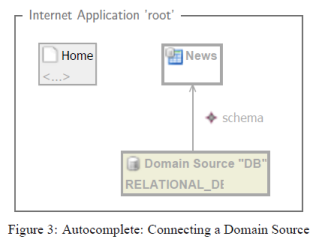Labelled Frames in Latex
 I wanted to have a frame with a label in Latex, as in the image to the right.
I wanted to have a frame with a label in Latex, as in the image to the right.
One solution provided by the VisualFAQ is to use the fancy verbatim class:
\begin{Verbatim}[frame=single,label={\texttt{equidem.tex}}]
However, I didn’t want text; I wanted an image, and I wanted in a consistent font.
I found the solution was the following Latex:
\begin{figure}[htb]
\centering
\begin{tabular}{@{}lllr@{}}
& \multirow{2}{*}{Internet Application 'root'} & & \\
\cline{1-1} \cline{3-4}
\vline & & & \vline \\
\vline & \multicolumn{2}{c}{\includegraphics[width=80mm]{models/Source.ps}} & \vline \\
\hline
\end{tabular}
\caption{Figure Caption}
\label{fig:reference}
\end{figure}
Making it Coloured
I also wanted the frame to be a shade of gray. By using \arrayrulecolor, the \hlines of a table can be coloured:
\arrayrulecolor{gray}
Using \color directly allows you to change the colour of vertical lines (but NOT horizontal lines through \cline):
{\color{gray}\vline}
I also wanted to change the font of the label to a sans-serif font through \sffamily. My solution was thus:
\begin{figure}[htb]
\centering
\begin{tabular}{@{}lllr@{}}
& \multirow{2}{*}{\color{gray}\sffamily Internet Application 'root'} & & \\
\arrayrulecolor{gray}
\cline{1-1} \cline{3-4}
\arrayrulecolor{gray}
{\color{gray}\vline} & & & {\color{gray}\vline} \\
\arrayrulecolor{gray}
{\color{gray}\vline} & \multicolumn{2}{c}{\includegraphics[width=80mm]{models/Source.ps}} & {\color{gray}\vline} \\
\hline
\end{tabular}
\caption{Figure Caption}
\label{fig:reference}
\end{figure}
Making it a Command
Finally, I wanted to make this a re-usable command:
\begin{figure}[htb]
% param1: the frame caption
% param2: the image width
% param3: the image source
% param4: the image caption
% param5: the reference label
\framedimage{Internet Application 'root'}
{80mm}
{models/autocomplete/Source.ps}
{Autocomplete: Connecting a Domain Source}
{fig:autocomplete-source2}
\end{figure}
This is achieved by adding the following source code to your prelude.